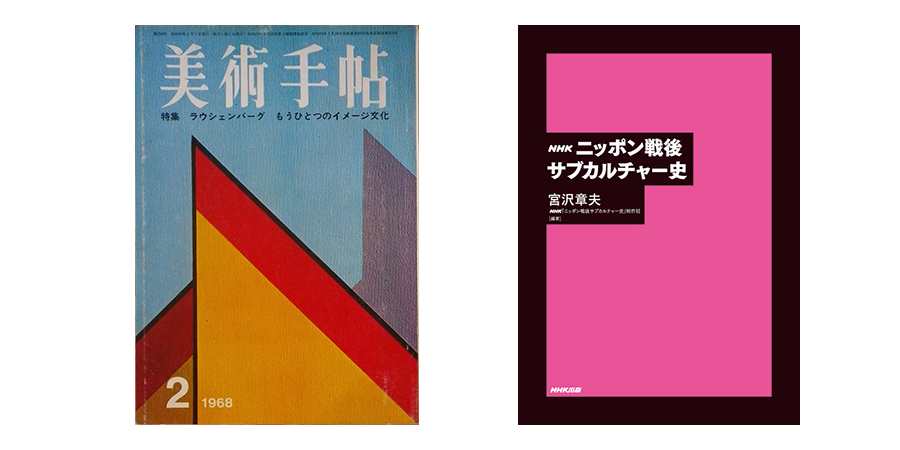Subculture in Japan
How does this theory apply to Subculture in Japan after WWII? Akio Miyazawa, arguing in his Nippon Sengo Sabu Karucha Shi(4) [A History of Subculture in Japan after WWII] (2014) [fig.1], in which he deals with his personal memories from 1960s through 1990s, points out that at the beginning Japanese subculture was greatly influenced by American West Coast counter culture (chapter 1). According to Miyazawa, the word “subculture” first appeared in Japanese documents when an article by Kenji Kanesaka, a visual artist and critic, was published in Bijutsu Techo [Art Notebook] magazine [fig.2] in February Issue of 1968.
 (Right) Fig.1 Nippon Sengo Sabu Karucha Shi [A History of Subculture in Japan after WWII], Akio Miyazawa, Tokyo: NHK Shuppan, 2014.
(Left) Fig 2 Bijutsu Techo, Bijutsu Shuppan-sha, Magazine, Feb 1968
(Right) Fig.1 Nippon Sengo Sabu Karucha Shi [A History of Subculture in Japan after WWII], Akio Miyazawa, Tokyo: NHK Shuppan, 2014.
(Left) Fig 2 Bijutsu Techo, Bijutsu Shuppan-sha, Magazine, Feb 1968
His article, “Wakudeki heno Izanai: Kyampu to Hippi Bunka(3) [An Invitation to Indulgence: Camp and Hippie Subculture],” Kanesaka points out that people are witnessing a big transition of industrial art from straight lines to winding and curvy lines which could be compared to Art Nouveau at the turn of the century. Seeing the traditional rules of art and the traditional sense being free, licentious color combinations are now flourishing in, the so called, Hippie Culture, Kanesaka mentions this cultural phenomenon is “bad taste,” and “this could be called subculture, which is yet to be culture” (3),p.87. It is interesting that Kanasaka seems to believe that subculture is not yet culture, as if subculture were, in other words, an immature condition that has yet to become culture, even though subculture has the power to break through the traditional sense of value.
Sabukaru and Subculture
Roughly since 1990s, “subculture” has been often abbreviated as “sabukaru” when we talk about Japanese subcultures. One of the first documents which include “sabukaru” is, as far as we researched, Eiji Otsuka’s Sengo Minshushugi no Rihabiritaishion(5) [Rehabilitation of Democratization after WWII] (2001). In Otsuka’s context, sabukaru connotes a sort of junk-ness and ephemerality. Subcultures in the Japanese context may not indicate cultures in ethnic or regional subgroups as Gordon points out. Japanese subcultures may rather indicate marginality, immaturity, ephemerality, or vulnerability. Subcultures in a contemporary sense generally refer to popular culture including animation, manga, video games and popular music. And yet, we need to recognize that “subculture” holds imbricated meanings.
Now, how do you define “subculture”?
To share a under-movement among plain citizens, like bad quality music???MANEA??


Comments